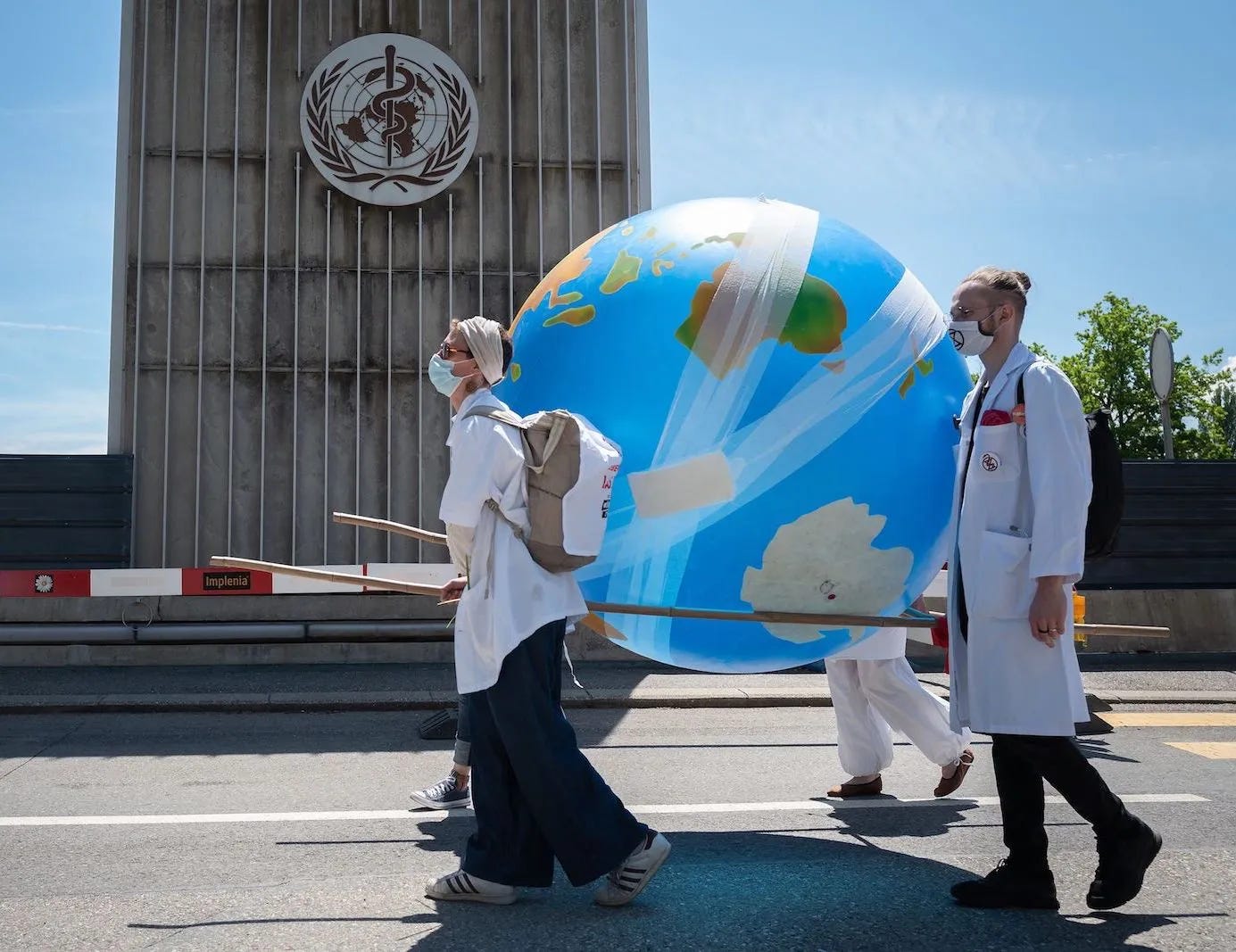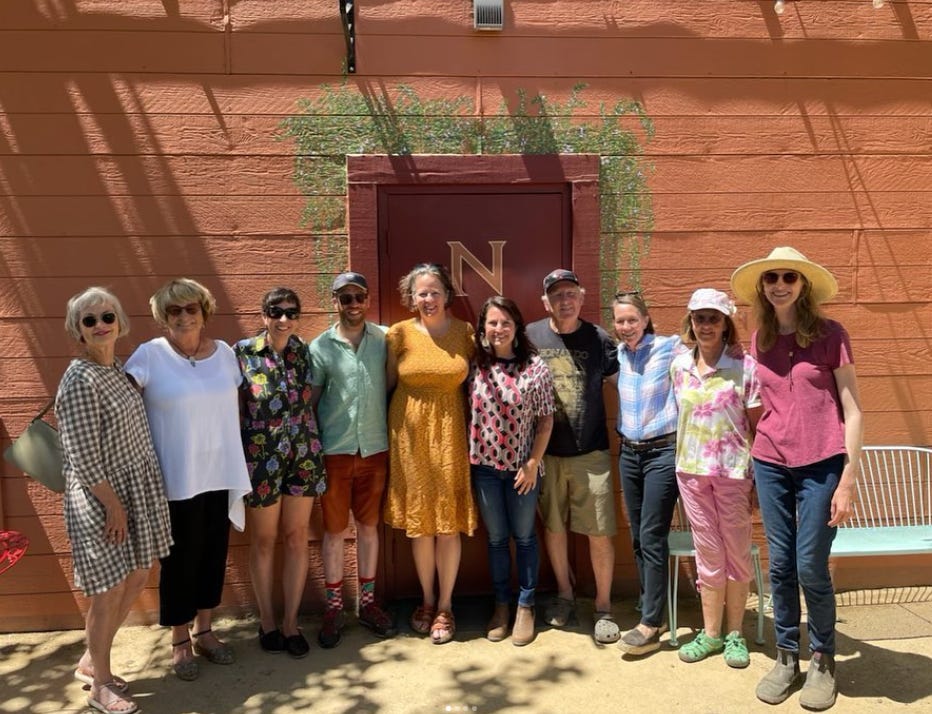Is there a doctor on the planet?
Facts: climate action for health professionals; Feelings: Feeling the climate love!; Action: Wine industry climate leadership
Hi friends, I’m back at the keyboard after a glorious unplugged vacation (did you miss me in your inbox in June??). Simon and I ate all the food, drank all the wine, climbed mountains, read novels, combed beaches, and hugged our family and friends. I’m reminded how nourishing these things are for me. I hope you’re able to have some rest and renewal this summer!
I’ll admit it’s slow to start up work again, but one thing I was excited to dive back into is working on the personalised climate action guide I recently got funding to develop.
I want to make the guide as useful as possible for YOU, dear We Can Fix It reader— so I would be really happy if you would please answer this quick survey (it’s only 3 questions). Thank you!
Without further ado, onto the facts, feelings, and action!
Facts: Climate action for health professionals

Healthcare professionals are highly trusted, and have high leverage to enact change. They are excellent climate messengers and effective changemakers.
But what messages, demands, and behaviours line up with health professionals’ expertise in protecting public health, while also making a real difference for climate?
Happily, Seth Wynes just answered this question in a new comment, currently available as a preprint [Update: final version was published September 2022 in The Journal of Climate Change and Health]. He writes,
“Advocating for governmental climate action, advising their patients to enjoy healthier, low-carbon lifestyles, and modeling the low-carbon transition in their homes and workplaces are key strategies that leverage health professionals’ existing strengths.”
Highlights of Seth’s evidence-based climate action guide for healthcare workers:
Climate advocacy
Join existing organisations
Get media attention.
Focus on elections: endorse bold climate candidates and ballot initiatives.
As a private citizen
Call or meet with your rep (tips from We Can Fix It, March 2021).
Vote for and donate to strong climate candidates.
Local politics
“City councils that zone for endless single-family neighbourhoods are building environments that override residents’ ability to make good decisions for their own health and for the climate. If Chambers of Commerce can actively lobby for more car infrastructure and its accompanying sprawl, then physicians should feel empowered to lobby for the opposite.
Few voices are likely to resonate more at a municipal council meeting than a trusted general practitioner explaining the link between urban form and health outcomes. Likewise, paramedics and emergency room professionals can describe to city councils the frequency and severity of injuries they treat from car crashes, while physiotherapists can elaborate on the lingering disabilities caused by those same incidents.”
Lobby your city council
Support compact, walkable, mixed-use neighbourhoods.
Support initiatives that disfavour cars and promote pedestrians and cyclists, like congestion charges, reduced city parking, and infrastructure for walking and biking.
National politics
Support policies to power electricity and transport with clean energy that will be passed and implemented quickly.
Appropriate policies depend on context, but generally make fossil fuels less convenient and more expensive, and subsidise, encourage, or require renewable energy production, storage, or transmission. Healthcare professionals can let policymakers decide on the best mix of incentives and regulations, but should “side forcefully against [doing] nothing.”
Advising patient lifestyles
Encourage plant-rich diets and active lifestyles (like living close to work, and walking or biking there).
Recommend replacing gas stoves with electric (especially to new parents; the fumes are especially harmful to developing kids) and replacing gas furnaces with electric heat pumps.
Role modelling
Take high-impact climate actions yourself: avoid air travel; go car free, or get an electric car; eat a plant-based diet. Practicing what you preach makes climate advocacy more persuasive.
As a professional
“[H]ealth professionals can aim to influence workplace norms, hiring practices, building emissions, and purchasing strategies that are currently high in carbon.”
Switch residency interviews to digital, or a centralised location.
Work to reduce supply chain emissions by better measuring and managing the climate impact from facilities like clinics, schools, hospitals, and vehicle fleets.
Read Seth’s full advice here, and share with your favourite doctor, nurse, paramedic, physiotherapist, and other health professional.
Hungry for more? Check out this recent special issue on climate and health solutions from healthcare professionals, with topics like greening conferences, discussing climate change in clinical encounters, med school climate curricula, and reducing clinic waste.
Feelings: Feeling the Climate Love!
After 2+ years of almost entirely virtual interactions with colleagues and readers, it’s been soul-filling to start meeting face-to-face with nearby folks.
On one of my precious trips home to Sonoma, California last month, Simon and I were lucky to be hosted for lunch in Healdsburg by a group of friends and neighbors who got together to read Under The Sky We Make. (In Chapter 9, I write about how I’ve reduced my flights more than 90%, and my expired frequent flyer card is where it belongs— in a museum, but I still take an annual flight home to see family.)
After reading and discussing, the group decided to form We Are Talking About It— a monthly gathering to help channel their climate despair into action. They’ve become an amazing local climate action powerhouse. Group members are attending city council meetings, hitting the streets with creative demonstrations, growing their own (delicious!) veggies, taking train and bike holidays, contributing labor for local farmers, reducing wine packaging, setting up a table to talk about climate action at the local farmers market, and more.
Sitting around a table in dappled shade, sharing food and wine grown with care on the beautiful rolling hills surrounding us, what struck me was the group’s joy. It shone through from their shared stories and laughter, and their active listening and support for each other.

It was a great reminder that we all need to keep refilling our cups— and one of the best ways to do so is together. As the We Are Talking About It gang shared in their post, “taking time to rest, restore, laugh, have a picnic, and make new friends is a tool to help keep us going.”
Action: Wine industry climate leadership
I grew up on my family’s vineyard, and studied the impact of climate change on winegrowing in Sonoma and Napa for my PhD. Wine is close to my heart!
So I am very heartened that the wine industry is taking climate leadership seriously. One of my favourite initiatives is:
International Wineries for Climate Action
What I love about this group is their clear, science-based approach. IWCA focus on what matters most: *actually reducing emissions*. Members who join do this by:
Measuring current baselines and annual emissions to inform reduction strategies (they’ve created an Excel greenhouse gas calculator to help). Remember, “What gets measured, gets managed.” Check out their members’ data below!
Not just committing to Net Zero 2050 (reminder from We Can Fix It May 2021 on why that’s not enough), but also to make ongoing reductions to meet 2030 goals. Check out their rigorous membership requirements— no room for greenwashing here!
Sharing knowledge on best practices to inspire industry action, like in their report on regenerative farming.

At the recent Napa THRIVES event, Educational Winemaker & Sustainability Manager Molly Sheppard shared emissions data from Spottswoode Estate. While they’re committed to make ongoing improvements in the vineyard and winery, Spottswoode is already near the cutting edge in terms of best practices for their own operations (called “Scope 1” emissions). There isn’t a lot more room to cut Scope 1 emissions.
With about 80% of their total emissions coming from goods and services that Spottswoode purchases, like packaging and shipping their wines (Scope 3), Molly noted the need for collaboration across the whole supply chain: “Your Scope 3 emissions are someone else’s Scope 1.”
Led by President and CEO Beth Novak Milliken, Spottswoode is also thinking about how they can share their story and love of wine to inspire their customers to take more climate action. (They generously included a copy of Under the Sky We Make with a recent wine shipment to their top customers!)
If you’re looking to learn more about climate change and wine, check out “What Can Wine Tell Us About the Future of Life On Earth?” (45 min talk), “Wine Lover, the Climate Needs YOU!” (15 min talk), or my article for Scientific American, “Will We Still Enjoy Pinot Noir?”
Parting tidbits

Book recommendation
To Boldly Grow: Finding Joy, Adventure, and Dinner in Your Own Backyard, by Tamar Haspel. Great reading for this time of natural abundance. Accessible, unfussy, hilarious inspiration to get outside and learn about first-hand food by growing and harvesting it for yourself.
And on that note— I’m off to glean cherries and pick gooseberries and the first round of apples from our tree. Have a lovely weekend!
xo,
Kim






Your intro was the best! 'drank all the wine' -sounds like my house. And I'm encouraged that the wine industry is invested in climate change. Not surprised, but happy to learn that. Mostly because I can keep drinking my wine without guilt. As it should always be enjoyed. ;)